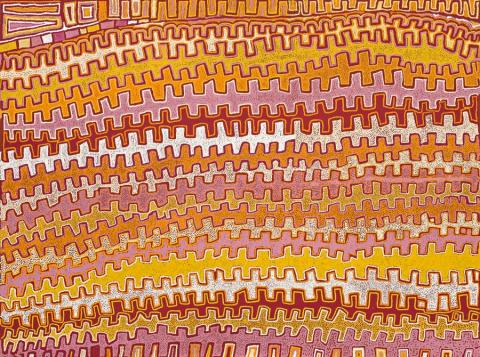NGARRU, 2004
PATRICK TJUNGURRAYI
synthetic polymer paint on linen
181.5 x 243.5 cm
inscribed verso: artist's name, size and Papunya Tula Artists cat. PT0407201
Executed at Kiwirrkura, 2004
Papunya Tula Artists, Alice Springs
Private collection, New South Wales
Patrick Tjungurrayi was born deep in the Western Desert at Yalangerri (near Jupiter Well) on the Canning Stock Route, about 200 kilometres west of Wilkinkarra (Lake Mackay) around 1940 and lived with his family group moving from rockhole to rockhole through Pintupi country. By the 1940s Anangu (people of the Western Desert cultural bloc) were vacating their homelands to various settlements on the fringe of the desert. In the late 1950s Tjungurrayi's group walked out of the desert and settled at Balgo. In the mid-1980s after many years of moving across the country Tjungurrayi returned to Balgo, where he began painting (under the name Patrick Olodoodi Tjungurrayi) for the newly established Warlayirti Artists. This great migration out of the desert during the mid-twentieth century and then back again in the 1980s shaped his life and art. A few years later he moved to Kiwirrkurra and began painting for Papunya Tula Artists but he returns regularly to Balgo. At first he painted in different styles, depending on whether he was in Balgo or Kiwirrkurra, but more recently he has developed a hybrid of the two. In combining the colour of Balgo art with the geometry of the classic Papunya Tula style, his paintings symbolically reunite Anangu culture from around Wilkinkarra.
Tjungurrayi regularly paints his country around Yalangerri and the setting for this painting is the lake at Ngarru, west of Jupiter Well in the Gibson Desert, where a large group of mythical ancestral Tingari Men camped on their journey east to Tarkul and on to Wilkinkarra (Lake Mackay). The designs in the painting relate to those used in rituals associated with the Tingari where the law is revealed to initiates. The painting evokes the spiritual nature of the landscape, endowed by the life-sustaining powers of the ancestors.
